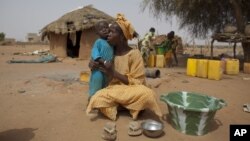From VOA Learning English, this is the Agriculture Report in Special English.
In Africa, severe food shortages have affected eighteen million people in nine Sahel countries this year. This was the third severe food crisis in four years in the area bordering the Sahara. How can the Sahel break its cycle of food insecurity? Aid workers are asking that question as this year's emergency eases. David Gressly is the United Nations regional humanitarian coordinator for the Sahel.
"If we don't seize the opportunity in two thousand thirteen, there's a good chance that this whole issue will be forgotten until the next drought, and then we'll be asking ourselves the same set of questions."
Mr. Gressly says during a crisis, families eat just one or two meals a day, take their children out of school, sell their animals and go into debt. These actions put them at greater risk in a future crisis. In fact, many of the families affected by this year's food crisis had yet to recover from the earlier ones.
Aid agencies sent food and emergency assistance. They supplied farmers with drought-resistant seeds, improved fertilizers and medicine for livestock. Aid groups also worked to improve irrigation systems and grain storage. These measures dealt with short-term needs, but David Gressly says the work should not stop when the crisis eases.
"And I think now there's an understanding [of the need for] a very targeted program looking at these eighteen million people affected this year, working with them to find ways so that they don't have to make the kinds of decisions to survive in a crisis of a drought, for example, that compromises their long-term future."
Aid groups say they are working to build the "resilience" of communities, to make them stronger during a crisis. David Gressly says this means taking steps like reducing child malnutrition and changing cultural practices that may be harmful.
For example, he says there is a practice in many communities across the Sahel to give water to babies under six months of age because of the heat. But the water is often dirty and makes the children sick. This starts a cycle toward severe malnutrition. It can be prevented by feeding babies only breast milk.
This year's food crisis followed unpredictable and insufficient rains. High food prices only made the situation worse. David Gressly says aid agencies in Chad have been building dams to store water during the rainy season. This water can later be used to irrigate fields.
Al Hassan Cisse from the British aid group Oxfam says building the resilience of poor people also means investing in food reserves and social protections like health care. Aid groups say prevention costs less than treatment.
In Africa, severe food shortages have affected eighteen million people in nine Sahel countries this year. This was the third severe food crisis in four years in the area bordering the Sahara. How can the Sahel break its cycle of food insecurity? Aid workers are asking that question as this year's emergency eases. David Gressly is the United Nations regional humanitarian coordinator for the Sahel.
"If we don't seize the opportunity in two thousand thirteen, there's a good chance that this whole issue will be forgotten until the next drought, and then we'll be asking ourselves the same set of questions."
Mr. Gressly says during a crisis, families eat just one or two meals a day, take their children out of school, sell their animals and go into debt. These actions put them at greater risk in a future crisis. In fact, many of the families affected by this year's food crisis had yet to recover from the earlier ones.
Aid agencies sent food and emergency assistance. They supplied farmers with drought-resistant seeds, improved fertilizers and medicine for livestock. Aid groups also worked to improve irrigation systems and grain storage. These measures dealt with short-term needs, but David Gressly says the work should not stop when the crisis eases.
"And I think now there's an understanding [of the need for] a very targeted program looking at these eighteen million people affected this year, working with them to find ways so that they don't have to make the kinds of decisions to survive in a crisis of a drought, for example, that compromises their long-term future."
Aid groups say they are working to build the "resilience" of communities, to make them stronger during a crisis. David Gressly says this means taking steps like reducing child malnutrition and changing cultural practices that may be harmful.
For example, he says there is a practice in many communities across the Sahel to give water to babies under six months of age because of the heat. But the water is often dirty and makes the children sick. This starts a cycle toward severe malnutrition. It can be prevented by feeding babies only breast milk.
This year's food crisis followed unpredictable and insufficient rains. High food prices only made the situation worse. David Gressly says aid agencies in Chad have been building dams to store water during the rainy season. This water can later be used to irrigate fields.
Al Hassan Cisse from the British aid group Oxfam says building the resilience of poor people also means investing in food reserves and social protections like health care. Aid groups say prevention costs less than treatment.
